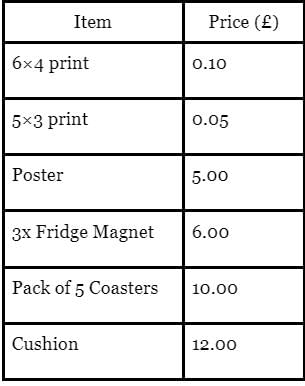Practice Questions: Decision Making - UCAT MCQ
20 Questions MCQ Test - Practice Questions: Decision Making
The sales data for three distinct magazines is presented in the table below. Each magazine has two versions available: a standard edition with 300 pages and a deluxe edition with 400 pages. The standard edition is priced at £8.99, while the deluxe edition is priced at £13.99.

Which of the following statements is true?


A collective of artists collaboratively accepts commissions, with each oil painting requiring 20 hours and each watercolor painting taking 15 hours. Their only constraint is the amount of time available.
Which of the following orders can they not fulfil in a month?

A collective of artists collaboratively accepts commissions, with each oil painting requiring 20 hours and each watercolor painting taking 15 hours. Their only constraint is the amount of time available.
Jonny's photos are currently offering a special promotion. New customers can enjoy a 40% discount on their initial orders. Additionally, there is a fixed delivery fee of £3.50 applied to every order. The regular prices are as stated below:

Given that Dan is a new customer, which of the following statements is correct?

Dodos may not consistently exhibit weakness, but they consistently possess zipzap qualities. While not all creatures with zipzap traits are weak, they will inevitably acquire boing characteristics.
Which statement does not follow?
All beach locals who like tea also have a liking for coffee, and all the locals present on the beach were of German nationality. None of the locals on the beach had a preference for eggs, but there were a few who enjoyed drinking tea. Additionally, every local on the beach had an interest in photography.
Which statement does follow?
In this shopping center, there are shops that don't sell clothes, but all the shops in the shopping center are at least 300 square meters in size, except for two shops that exclusively sell books.
Which statement does not follow?
All dogs in this park are well-behaved.
Some animals in this park are well-behaved.
Select the conclusions which follow the statement:
No roses in this garden are red.
Some flowers in this garden are red.
Select the conclusions which not follow the statement:
All students who study hard pass the exam.
Some students pass the exam.
Select the conclusions which follow the statement:
All athletes who train regularly are fit.
Some fit people are athletes.
Select the conclusions which not follow the statement:
A study conducted on a group of individuals found that those who exercise regularly have lower cholesterol levels. It is also known that individuals with lower cholesterol levels have a reduced risk of heart disease.
Select the conclusions which follow the statement:
A survey was conducted among a group of students to determine their preferred mode of transportation to college. The results showed that 60% of the students preferred cycling, 30% preferred public transportation, and 10% preferred walking.
Select the conclusions which does not follow the statement:
A company conducted an experiment to test the effectiveness of a new advertising campaign for their product. The campaign was shown to two groups of participants: Group A and Group B. Group A was exposed to the campaign on television, while Group B was exposed to the campaign through online platforms. The company found that Group B showed a higher increase in product sales compared to Group A.
Select the conclusions which follow the statement:
A recent study found that people who consume more fruits and vegetables have a lower risk of developing heart disease. The study involved a large sample size and accounted for various confounding factors such as age, gender, and smoking habits.
Which is the conclusion that does not follow.
A study compared the academic performance of students who attended an after-school tutoring program with those who did not receive any additional support. The results showed that students in the tutoring program performed better on average than their peers who did not participate.
Which is the conclusion does follow.
An experiment was conducted to investigate the effects of caffeine on cognitive performance. The results showed that participants who consumed caffeine prior to the test performed significantly better than those who did not consume caffeine. The experiment included a diverse group of participants with varying ages and educational backgrounds.
Which is the conclusion that does not follow.
A survey was conducted to gather feedback from customers about a new product. The survey results showed that 80% of the respondents found the product to be user-friendly and 90% of the respondents would recommend it to others.
Which is the conclusion that does not follow.
In a study on the effects of caffeine on cognitive performance, participants were divided into two groups. Group A consumed a caffeinated beverage before the test, while Group B consumed a non-caffeinated beverage. The cognitive performance of both groups was measured using a standardized test. The results showed that Group A performed significantly better than Group B.
Which is the conclusion does follow.
A survey was conducted to investigate the relationship between exercise and stress levels. Participants were asked to rate their exercise habits and their stress levels on a scale from 1 to 10. The results showed that individuals who engaged in regular exercise reported lower stress levels compared to those who did not exercise regularly.
Which is the conclusion that does not follow.
According to a survey conducted by a university, 60% of students prefer coffee over tea. The survey included 500 students from different faculties. Based on this information, determine if the following conclusions can be drawn:
Which is the conclusion that does follow.














